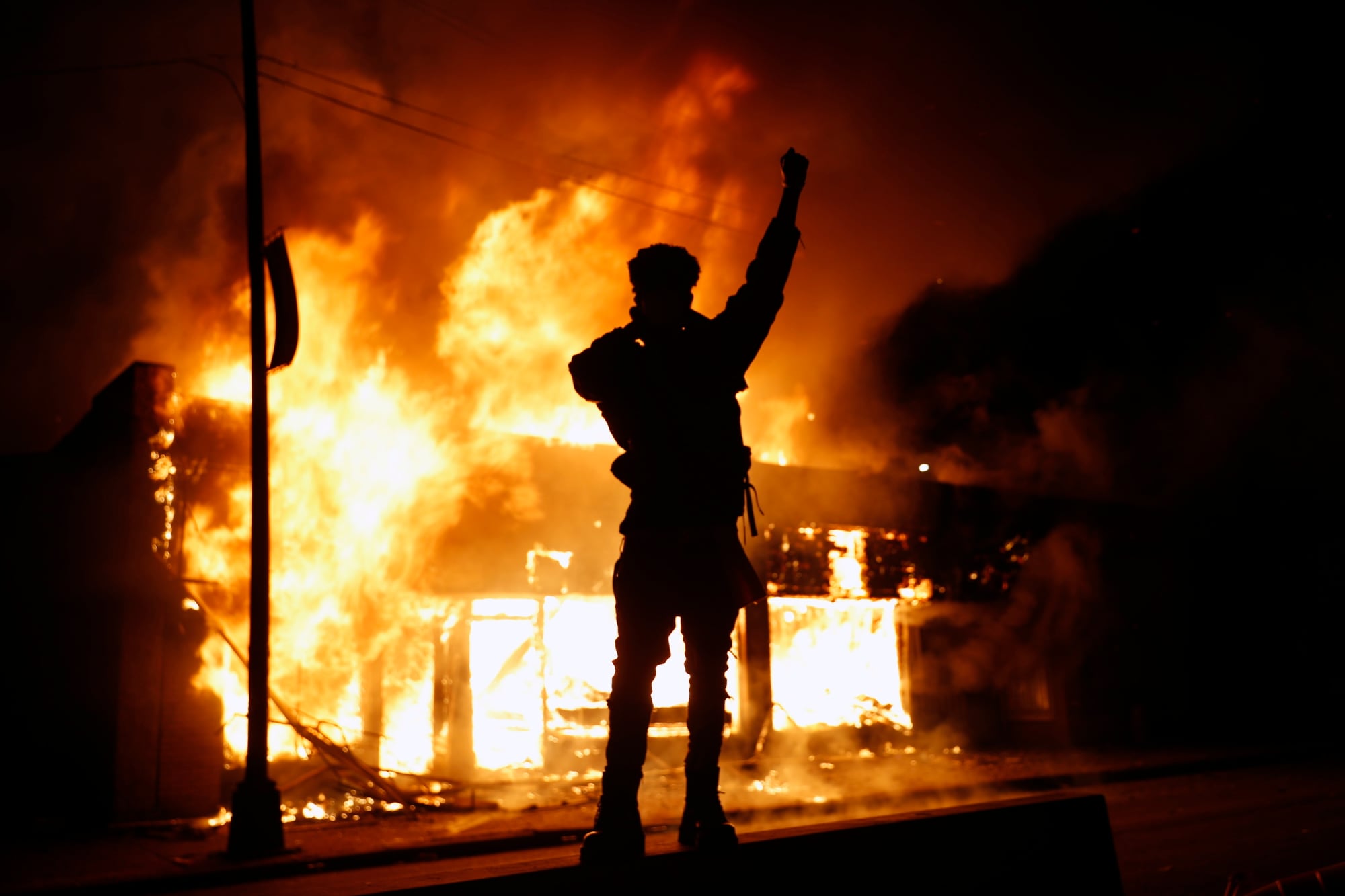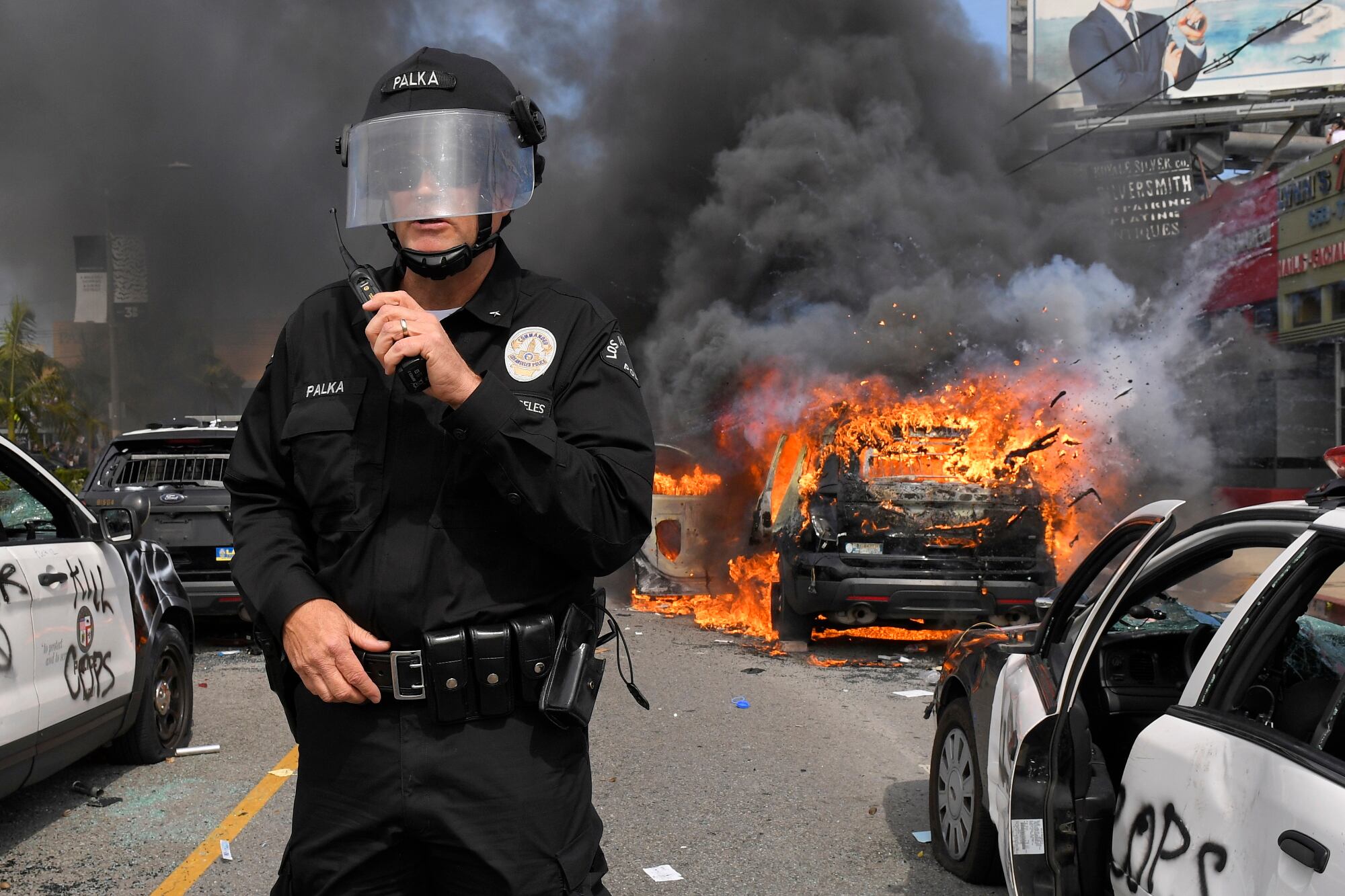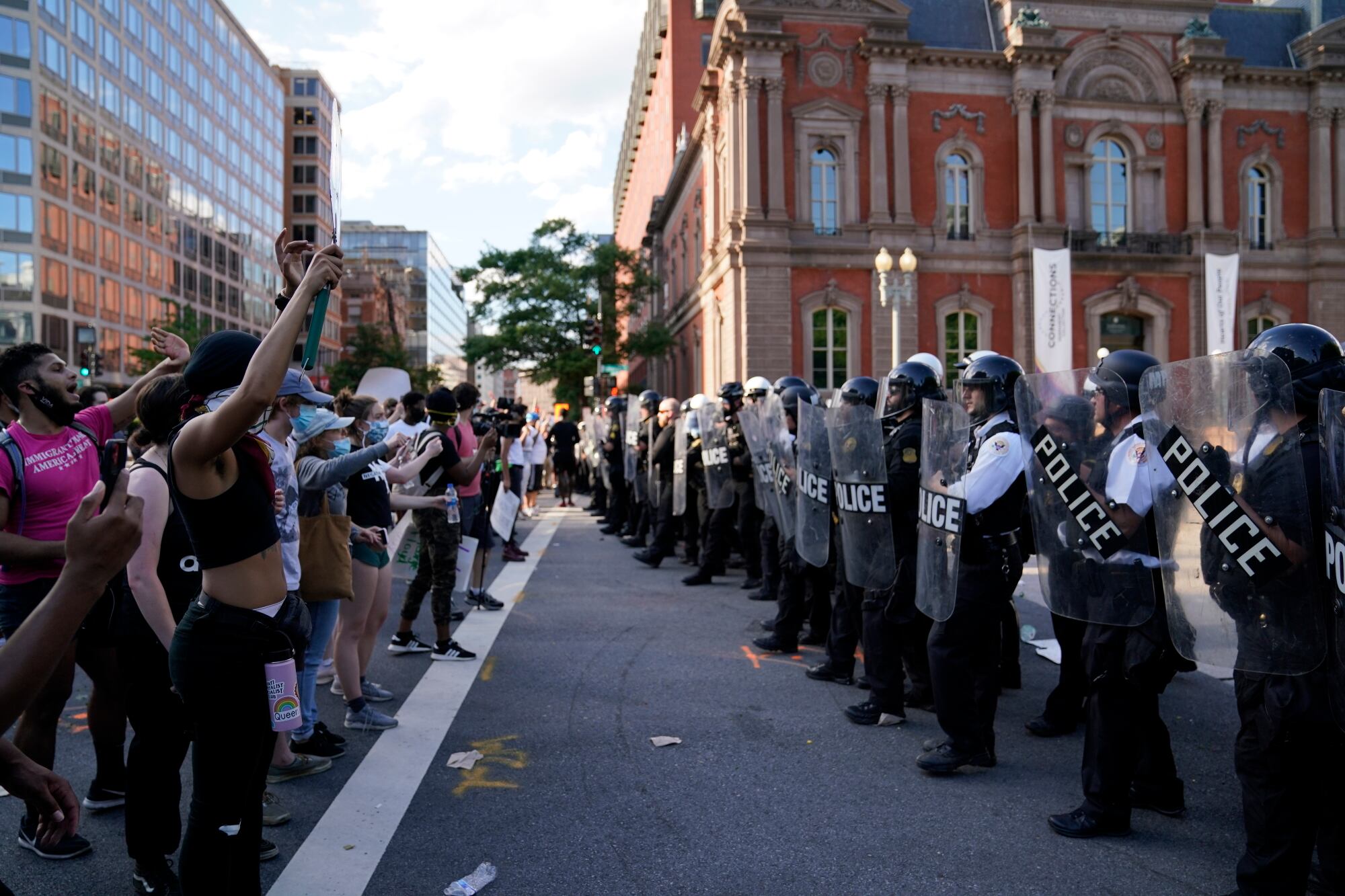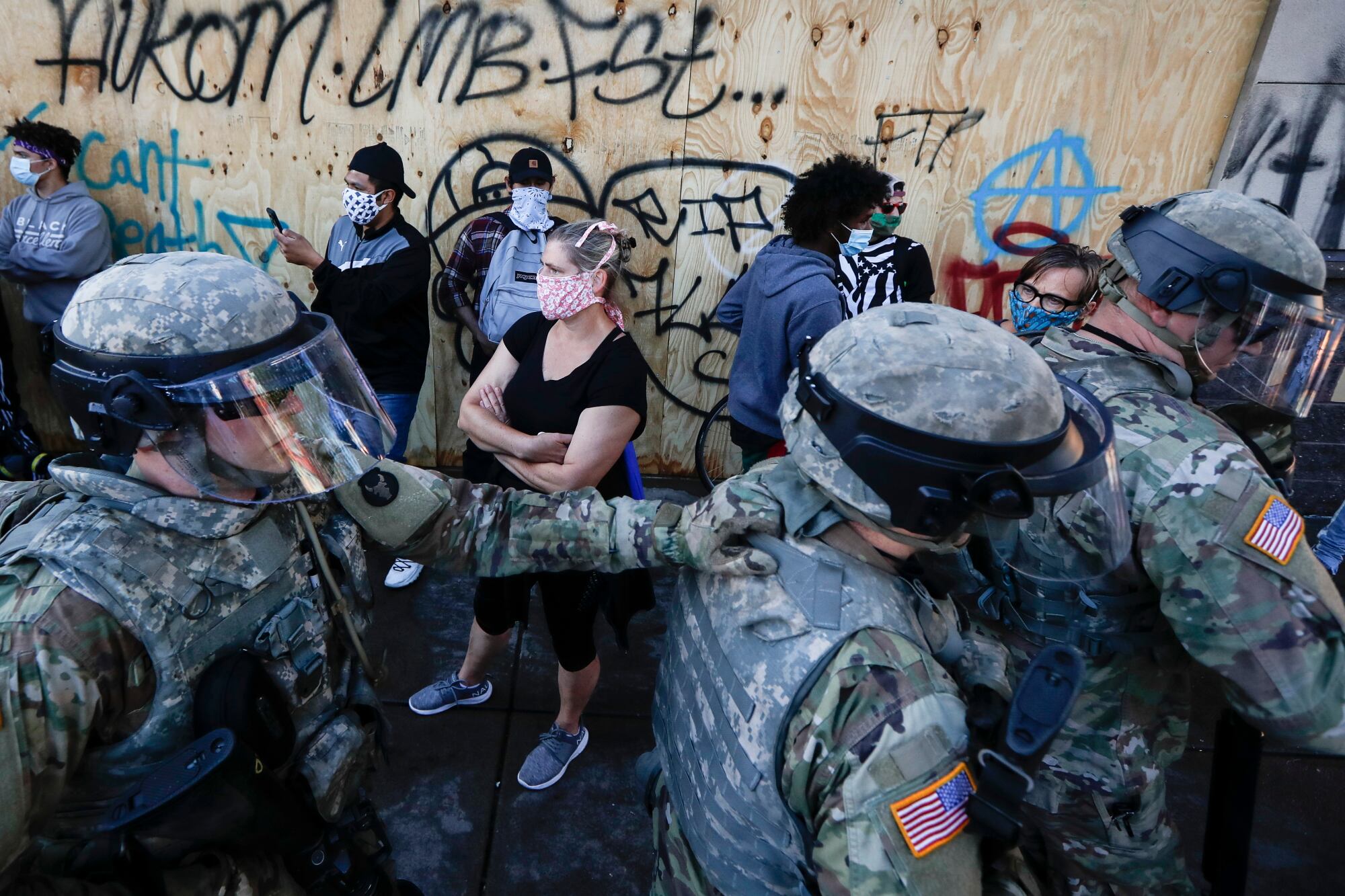As cities across the nation are burning after several days of rage over what prosecutors say was the murder of a handcuffed black man by Minneapolis police, about 5,000 National Guard troops in 15 states and the District of Columbia have been activated to help quell the unrest.
Another 2,000 Guard members are prepared to activate if needed, according to April Cunningham, a National Guard Bureau spokeswoman.
“State and local law enforcement agencies remain responsible for security,” according to a National Guard media release. “The National Guard personnel assigned to these missions are trained, equipped and prepared to assist law enforcement authorities with protecting lives and property of citizens in their state.”
National Guard troops “live in the communities they serve, and are there to protect their neighbor’s right to protest peacefully,” the release states. “Governors have used Guard members many times during response efforts to support local and state law enforcement in a wide range of capacities, to include assisting in upholding the rule of law. While conditions may change the National Guard's ability to respond is constant.”
The National Guard troops are responding under the direction of their governor are traditional part time guardsmen operating under State Active Duty orders with state and local law enforcement as the lead agency, according to Army Master Sgt. Michael Houk, a National Guard Bureau spokesman.
National Guard soldiers and airmen have been activated for this situation in Colorado, Georgia, Indiana, Kentucky, Minnesota, North Carolina, Ohio, Pennsylvania, South Carolina, South Dakota, Tennessee, Texas, Utah, Washington state, Wisconsin and Washington, D.C.
Houk told Military Times that the duration of the activations is unknown at this time.
“The National Guard will remain on mission as long as they’re needed,” he said.
In Minnesota, Gov. Tim Walz said he spoke twice with Defense Secretary Mark Esper and Army Gen. Mark Milley, chairman of the Joint Chiefs of Staff, sharing notes and asking DoD for additional help that includes signals intelligence to help figure out how the protesters are organizing.
However, a DoD official, speaking on background, said "there was no offer nor ask for DoD to provide Signal Intelligence and DoD is not providing any to the state.”
RELATED

Pentagon spokesman Jonathan Rath Hoffman said Saturday that "at this time there is no request by the governor of Minnesota for Title 10 forces to support the Minnesota National Guard or state law enforcement.”
However, as "a prudent planning measure, the department has directed U.S. Northern Command to increase the alert status of several units should they be requested by the governor to support Minnesota authorities. These are units that normally maintain a 48-hour recall to support state civil authorities.
When it comes to rules on use of force and how Guard troops are armed, officials say each state has its own playbook.
During a press conference Sunday evening, D.C. Mayor Muriel Bowser said she requested assistance from the D.C. National Guard for up to 500 troops.
Those troops have been activated and are not armed, Air Force Senior Master Sgt. Craig Clapper, a D.C. National Guard spokesman, told Military Times. They do have protective equipment like shields and batons, he said.
“They don’t do law enforcement,” said Clapper. “They are not to engage. They are in a support role.”
Clapper said the DCNG troops are “there to keep the crowd back. If someone tries to break the line, they will push them back.”
As a precaution, Army Secretary Ryan McCarthy, in coordination with Bowser, has activated the D.C. National Guard, according to an Army official.
“The authority to activate the D.C. National Guard has been delegated by the President to the Secretary of Defense and further delegated to the Secretary of the Army,” according to the Army official. “The D.C. National Guard is the only National Guard unit, out of all of the 54 states and territories, which reports only to the President. In this status they operate similar to a state National Guard unit in Title 32 status with the same legal authorities.”
During a Sunday afternoon media call, the heads of the Colorado, Georgia and Minnesota National Guards described their rules.
Colorado National Guard troops are unarmed, said Air Force Maj. Gen. Michael A. Loh, the Colorado National Guard’s adjutant general. That was a decision made Saturday in conjunction with the Colorado governor and mayor and police chief of Denver, Loh said.
“The Denver police chief said that ‘if we have to use deadly force, I want my police officers to do it and I want you to be in support.’”
Colorado Guard troops do carry defensive weapons, like batons, tasers and pepper spray, Loh said.
For the Georgia National Guard, the standard practice is for troops to protect themselves by carrying pistols, particularly in urban environments, said Army Maj. Gen. Thomas Carden Jr., the adjutant general of the Georgia National Guard.
“We can’t envision a situation, especially here in Atlanta, where we would need a rifle, if you will,” said Carden. “We don’t engage a threat from that far out.”
In Minnesota, National Guard troops are armed, but carry their ammunition in pouches, said Army Maj. Gen. Jon Jensen, the state’s adjutant general.
The troops are armed, said Jensen, because the FBI contacted Minnesota Guard officials saying they had received “a credible, lethal threat directed against the Minnesota National Guard.” Jensen declined to elaborate.
Jensen said Minnesota Guard troops are authorized to use proportional force in response to threats.
“I cannot exceed greatly the force upon which I am threatened with,” he explained. “I always maintain the inherent right of self defense.”
Minnesota Guardsman are not armed with rubber bullets or tasers, Jensen said.
All three National Guard leaders said their troops have not yet had to use force or defensive weapons.
The generals said their troops are largely guarding critical infrastructure like hospitals and government buildings, allowing local law enforcement to provide front-line services.
Jensen said despite the ongoing tensions in Minneapolis, where the unrest began, and neighboring St. Paul, he has not yet reached out to the Pentagon to provide troops for active duty.
He said his biggest need is for military police, but that can be provided by neighboring states under a nationwide Guard compact. He would not name the two states that have agreed to provide those troops.
Despite more than 40,000 Guard troops nationwide already dealing with a response to the coronavirus pandemic, the generals said that they are prepared for all missions. They added that the experience working with local law enforcement, health and other agencies has actually proven beneficial in the civil unrest response by speeding up and streamlining the process.
All three said that they can handle all missions while also providing troops for overseas operations.
And though Walz, the Minnesota governor, has talked about outside agitators fomenting trouble, Jensen declined to talk about the presence of groups like white nationalists, foreign elements or antifa, which Trump this afternoon declared by tweet will be designated a terrorist organization.
The Guard leaders all described how activation for civil unrest is an important duty they reluctantly perform.
“We in America should not get used to or accept uniformed service members of any variety put in a position having to secure people inside the United States of America,” said Carden of Georgia. “While we are glad to do it an honored to do it, it is a sign of the times we need to do better as country. We stand ready to be called on anytime, but I pray not have to do it again.”
Protests first erupted Tuesday, a day after George Floyd’s death in a confrontation with police captured on widely seen citizen video. On the video, Floyd can be seen pleading as Officer Derek Chauvin presses his knee against him. As minutes pass, Floyd slowly stops talking and moving. The 3rd Precinct covers the portion of south Minneapolis where Floyd was arrested. Chauvin, one of four officers fired from the force after Floyd’s death, was arrested Friday and charged with murder.
The Associated Press has written about activations in several states.
California
A fourth day of violence in Los Angeles prompted the mayor to impose a rare citywide curfew and call in the National Guard after demonstrators clashed repeatedly with officers, torched police vehicles and pillaged businesses in a popular shopping district.
Mayor Eric Garcetti said Saturday he asked Gov. Gavin Newsom for 500 to 700 members of the Guard to assist the 10,000 Los Angeles Police Department officers. The Guard members were expected to arrive early Sunday.
Garcetti said the soldiers would be deployed “to support our local response to maintain peace and safety on the streets of our city."
Firefighters responded to dozens of fires, and scores of businesses were damaged. One of the hardest-hit areas was the area around the Grove, a popular high-end outdoor mall west of downtown where hundreds of protesters swarmed the area, showering police with rocks and other objects and vandalizing shops. One officer suffered a fractured skull, Los Angeles Police Chief Michel Moore said.
When the curfew took effect at 8 p.m., police moved aggressively to get people off the streets and there was no repeat of the late-night rampage that occurred downtown Friday night and led to more than 500 arrests.

Community leaders denounced the violence that has accompanied protests over Floyd’s death.
There were protests in cities throughout California, from San Diego to San Francisco.
San Francisco's iconic Union Square saw people stealing leather bags from the Coach store and shoes from the Salvatore Ferragamo location, The Mercury News reported. Streets were littered with bras from Victoria's Secret and cushioned jewelry boxes from Swarovski. Police fired tear gas to disperse protesters.
San Francisco Mayor London Breed said a citywide curfew would go into effect from 8 p.m. Sunday to 5 a.m. Monday. She also asked the governor to put the National Guard on standby.
“People are hurting right now. They’re angry. I’m angry," Breed tweeted, “We can’t tolerate violence and vandalism."
San Francisco Police Chief Bill Scott said he understood why protesters are angry at police. But he warned that if anyone assaulted officers, “we will not tolerate that.”
Washington, D.C.
In Washington, the National Guard was deployed outside the White House, where chanting crowds taunted law enforcement officers. Dressed in camouflage and holding shields, the troops stood in a tight line a few yards from the crowd, preventing them from pushing forward. President Donald Trump, who spent much of Saturday in Florida for the SpaceX rocket launch, landed on the lawn in the presidential helicopter at dusk and went inside without speaking to journalists.

Georgia
Atlanta's mayor announced a curfew Saturday night and Georgia's governor authorized up to 1,500 National Guard troops to deploy throughout the city after a Friday night protest over the death in Minnesota of George Floyd turned violent.
Atlanta Mayor Keisha Lance Bottoms urged unity and nonviolence during a news conference Saturday evening. She said the curfew would be in effect from 9 p.m. Saturday to sunrise on Sunday, calling it a “very unusual and extreme step."
Bottoms, who made a passionate and personal plea to protesters the night before, also noted that Friday's demonstration, which began peacefully, took place amid a pandemic.
“If you were out protesting last night, you probably need to go get a COVID test this week," she said. "There is still a pandemic in America that’s killing black and brown people at higher numbers.”

Officials were also bracing for the possibility of new outbreaks of violence.
Atlanta Police Chief Erika Shields said at a news conference that they would have a zero tolerance policy Saturday night.
“Yes, you caught us off balance once. It’s not going to happen twice,” she said, later adding, “Quite frankly, I’m ready to just lock people up.”
Missouri
Gov. Mike Parson on Saturday evening activated the Missouri National Guard to help respond to protests around the state that he described as creating hazards to safety, welfare and property that are beyond the abilities of local authorities to manage.
But St. Louis County Executive Sam Page and state Rep. Raychel Proudie, a Democrat from Ferguson, urged Parson not to send the Guard members to the St. Louis area. They said nothing in the community is being destroyed, the St. Louis Post-Dispatch reported. Page said he’s spoken to the county’s police chief, who assured him that local law enforcement would be able to maintain safety.
Protests continued Saturday in the St. Louis area, in Kansas City and elsewhere in the state in response to the death of Floyd.
In Kansas City, five people were arrested in Saturday evening protests in and near the Country Club Plaza shopping and entertainment district, the Kansas City Star reported. Mayor Quinton Lucas had earlier told reporters that he knew there was a lot of pain in the community and nation and called on the hundreds gathered near the plaza to think about change and to protest peacefully.
Local media reported that police used tear gas to force protesters out of streets and onto sidewalks in the plaza area. The plaza managers announced earlier in the day that the shops and restaurants in the district would close Saturday afternoon and remain closed Sunday because of planned protests.
On the other side of the state, the Post-Dispatch reported about 500 people were protesting peacefully Saturday evening in Ferguson, where 18-year-old Michael Brown was fatally shot by Ferguson police officer Darren Wilson in 2014. The resulting protests strengthened the fledgling Black Lives Matter movement. Protesters marched in other St. Louis-area communities earlier in the day.
Minnesota
In Minneapolis, the city where the protests began, police, state troopers and National Guard members moved in soon after an 8 p.m. curfew took effect Saturday to break up protests, firing tear gas and rubber bullets to clear streets outside a police precinct and elsewhere.
The show of force came after three days when police largely avoided engaging protesters, and after the state poured in more than 4,000 National Guard troops to Minneapolis and said the number would soon rise to nearly 11,000.
“The situation in Minneapolis is no longer in any way about the murder of George Floyd,” said Gov. Tim Walz, who also said local forces had been overmatched the previous day. “It is about attacking civil society, instilling fear and disrupting our great cities.”
Minneapolis’ streets steadily grew calmer as the night went on, and Corrections Commissioner Paul Schnell said the tough response would remain as long as it takes to “quell this situation.”

Ohio
The governor of Ohio said he was calling out the Ohio National Guard and also asking the highway patrol to help enforce laws in Columbus as the mayor of that city and Cleveland both announced 10 p.m. curfews following damage to businesses amid protests over the death in Minneapolis of George Floyd.
Gov. Mike DeWine said the vast majority of protesters wanted “simply to be heard" and focus attention on the death of Floyd and other injustices.
“But the voices calling for justice, the voices calling for change, are sadly being drowned out by a smaller group of violent individuals ... (who) threaten the safety of our citizens, of the community," the Republican governor said. “Acts of violence cannot, and will not, be tolerated. This violence must stop."
Columbus Mayor Andrew Ginther said he believed racism “is a public health and safety crisis" and he wanted to see a more equitable city, but “we are now at a point that we can no longer tell who is protesting for change and an end to racism and who has only chaos and destruction in mind."
Ginther said more than 100 public and private properties had been damaged and at least 10 robbed of goods, five police officers were injured by thrown bricks or rocks and police vehicles had been set afire.
The Columbus Dispatch reported that U.S. Rep Joyce Beatty, Franklin County Commissioner Kevin Boyce and Shannon Hardin, president of the Columbus City Council, were among those pepper-sprayed at a protest Saturday morning.
South Dakota
South Dakota Gov. Governor Kristi Noem activated the National Guard after protests in Sioux Fall turned violent over the death of George Floyd in Minneapolis last week.
The Argus Leader reports the protest in South Dakota’s largest city started Sunday afternoon with a march downtown. Police said dozens of protesters later congregated at the Empire Mall and began throwing rocks at officers.
Several businesses in the area of the Empire Mall had windows damaged.
Police said protesters had dispersed by 11 p.m.
Noem said about 70 Guard members are in Sioux Falls and will remain until they are no longer needed.
“Rioting and looting will not be tolerated in South Dakota,” Noem said.
Utah
In Salt Lake City, protesters defied a curfew and National Guard troops were deployed by Utah’s governor. Demonstrators flipped a police car and lit it on fire, and another vehicle was later set ablaze. Police said six people were arrested and a police officer was injured after being struck in the head with a baseball bat.
Washington
Washington Gov. Jay Inslee late Sunday ordered a statewide activation of the National Guard following vandalism and thefts in stores and shopping malls in multiple cities following protests over the killing of George Floyd.
And police in Portland, Oregon, deployed incendiary devices to disperse a large crowd in downtown late Sunday night after authorities said projectiles – including aerial mortars – were thrown at officers.
Inslee had previously authorized 400 troops for Seattle and 200 troops for Bellevue. On Saturday night, people smashed downtown Seattle storefronts and stole items from many businesses, tossing mannequins into the street. On Sunday, there were thefts in stores and shopping malls in Bellevue, Spokane, Tukwila and Renton.
Inslee’s activation means more troops will be used to help control unrest.
“We must not let these illegal and dangerous actions detract from the anger so many feel at the deep injustice laid so ugly and bare by the death of George Floyd,” Inslee said in a statement. “But we also will not turn away from our responsibility to protect the residents of our state.”
This is a developing story. Please stay with Military Times for updates.
If you are serving with the National Guard in these efforts and want to talk about your experiences, please contact haltman@militarytimes.com
Howard Altman is an award-winning editor and reporter who was previously the military reporter for the Tampa Bay Times and before that the Tampa Tribune, where he covered USCENTCOM, USSOCOM and SOF writ large among many other topics.



